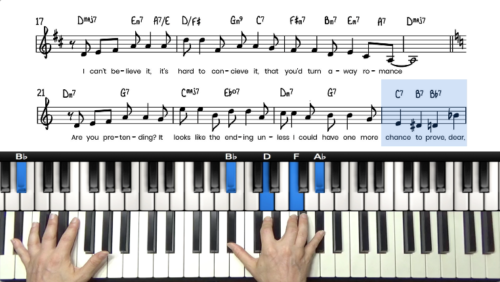Body & Soul For Beginners
In this lesson we create a beginner arrangement of the jazz piano classic “Body & Soul” using just roots, 3rds, and 7ths in our voicings.
3 Modulations In The Form
Body and Soul is a challenging tune to play. The A sections are in Db Major and then the tune modulates twice in the bridge, first to D Major, and then a whole step down tot C Major, before returning to Db Major for the final A section.
A Simplified Arrangement
We are going to be playing just roots, 3rds, and 7ths, and also pay special attention to the b7ths falling to 3rds in the 25 and 251 progressions.
We’re also going to add in a few extra chords here and there to create smoother transitions between the different sections of the tune.
Practice Tips
-
Understand the structure of the AABA Form and how memorising the form of tunes can speed up our memorisation of jazz standards.
-
The A sections of this tune repeat 3 times which makes it easy to neglect practice on the B section of the tune.
-
The B section of the tune modulates twice and so this 8 bars should be practiced in isolation to ensure you are comfortable and familiar with the chord changes.
-
This is a tricky jazz standard to learn so be patient when learning the chords and harmony.







Another gem. Looks like the website has a lot of content on this song. Looking forward to the challenge of learning this one. So much depth to this song.
Hi Adam 👋
Yes it’s a very nice tune. As you say there is so much variety and depth in the harmony.
I’ve been very much enjoying listening your performances by the way… thanks for sharing them.
Cheers!
Hayden
This one’s a great workout – with the modulation. I was wondering: is there a tutorial on this site that gives some tips on scales that can be used to improvise over these chords?
I’d also love to learn some walking bass techniques.
Hi Myles 👋🏻
The most productive and time-effective way to learn to improvise is to transcribe a solo from the song you want to improvise over. That way you will learn a lot about phrasing, feel, timing, articulation, accents, and other nuances and dynamics that can only be learnt from listening and transcribing.
Check out this video where I explain further: pianogroove.com/community/t/the-importance-of-listening-transcribing/2737
Also check out the ear training and transcription exercises in the forum: pianogroove.com/community/c/improvisation-exercises/30
Finally, yes I complied a forum post which contains walking bass lessons from 4 of our teachers, check it out here: pianogroove.com/community/t/walking-bass-line-lessons-from-4-teachers/3305
You can find links to many different lessons.
Let me know if I can help further.
Cheers,
Hayden
I can see how the stride movement has really helped with my timing. Is it mostly used when there is a rest at the start of the measure?
Hi Glenn 👋🏻
Glad to hear that the stride has helped with your timing.
Stride can be played in different styles such as ballad like this lesson, and also at faster tempos.
It doesn’t matter if there is a rest at the start of the measure or not.
Stride is particularly useful when we have a single chord for a whole bar, as it allows us to play the root low down, and then outline different extensions and/or alterations in our voicings.
Also experiment with alternating the stride pattern, so for example, we could start with the voicing and then play the bass note, instead of always starting with the bass note first. This can be useful to add more variety and interest to our performance.
I hope this helps.
Stay safe and enjoy the lessons!
Cheers,
Hayden
Hey there! Once more, could we please get a pdf of your transcript? They are so helpful!
Hi Branson,
Yes it’s on my to-do-list… I will get it uploaded for you asap.
Cheers!
Hayden
Any word on when this will be available?
Hi Branson,
I have just added the transcription. Apologies for the delay with this.
Also check out the advanced arrangement of this tune here: pianogroove.com/jazz-piano-lessons/body-soul-tutorial/ – we expand upon the concepts covered in this lesson.
Have a great weekend!
Cheers,
Hayden
Thank you so much! I really appreciate it!
Hey, Hayden. Your course is exactly what I needed to improve as a jazz pianist. You’re humble and a great teacher.
My question is when you say you toggle the notes when moving from chords, can you please explain to me when and how you know to do that? Thanks.
Hi Giovany,
Thanks for the comment and I’m glad you are enjoying the lessons.
Yes great question! Let me explain that further for you. First, watch the performance at the start of the video and notice what my left hand thumb is doing during the 1st A Section (from 0:10 to 0:40).
Instead of playing all of the notes at once in my left hand, I often play the bottom note and then the top note afterwards on a different beat of the bar. This helps to add simple rhythmic interest, it helps us to stay in time, and it helps us to outline the 4/4 pulse of the song.
Notice that for the 2nd A Section, (0:40 onwards) I introduce a stride style left hand, and so toggling the notes doesn’t apply here. It just applies to the 1st A section.
In the next courses we explore ‘rolling’ the notes of the chord up the keyboard which creates a similar effect and is used to add more movement and rhythmic interest in the left hand.
I hope that helps Giovany, and let me know if you have any other questions.
Cheers,
Hayden
Oh, I understand now. Thanks for making that clear to me!